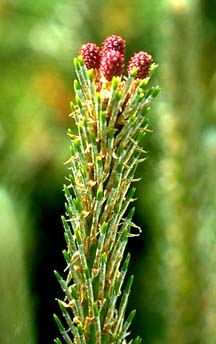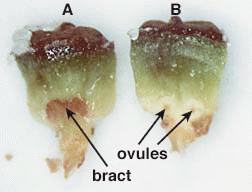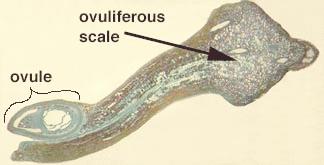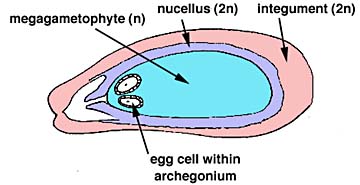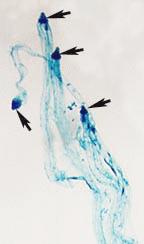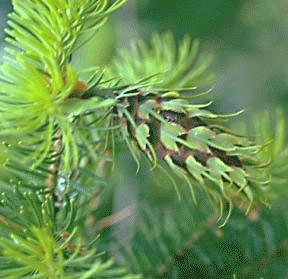Female cone of Pinus
This is what the female (seed) cone looks like when it is ready for pollination. About one year later is when fertilization occurs. You should understand the difference between pollination (transfer of pollen) and fertilization (the fusion of the gametes). Female cones (megastrobili) of Pinus . The cones become woody after pollination and during development of the female gametophyte.
Below is the demonstration that was in lab to show you the female cones at different stages. The cones are small and red (picture above) at the time of pollination. After about a year fertilization occurs. After about two years the seeds are mature and ready for dispersal.
Pinus female cone longitudinal section
Observe the longitudinal section and compare it with Raven 7th, p. 420, Fig. 18-19; 8th, p. 444, Fig. 18-21 and p. 478-479, Fig. 20-22. Locate the ovuliferous scale, the bract and the ovule. The bracts of pine remain very small so you will not be able to see them in mature cones.
The bract (br) is a modified leaf. Within the ovuliferous scale (ov) you can see a resin canal (r). The ovule is made up of the female gametophyte, surrounded by the nucellus (n) and the integument (i). The space in the integument is called the micropyle (m). When mature, the ovule becomes the seed. Observe the megasporocyte (also known as the megaspore mother cell. The megasporocyte (meg) will undergo meiosis to give rise to four haploid megaspores.
These are two ovuliferous scales which have been dissected from a seed cone (about one year old, about the time when fertilization occurs). The one on the left (A) is upside down so you can see the small bract. The scale on the right (B) demonstrates that there are two ovules per scale.
This is a picture of a longitudinal section through an older ovuliferous scale. The ovule has further developed as well. One of the four megaspores has developed into a multicellular female gametophyte (the other three die). The gametophyte will contain a number of archegonia.
This is a close-up of the ovule. The portion outlined in green is the gametophyte (gam) in which you can see archegonia (arch). You can also see the integument (int)and nucellus (nuc).
It is important that you understand what an ovule is. Here is a definition for you. An ovule is “an integumented nucellus”. Remember that the nucellus is the megasporangium. It houses the megaspore mother cell, the megaspore mother cell produces the megaspore, which develops into a female gametophyte, which produces eggs, which are fertilized and become zygotes, which ultimately develop into the embryos we find in the seeds. Throughout this development the integumented structure is considered an ovule, whether it is housing a megaspore or a developing embryo.
This is a cartoon of a longitudinal section through the ovule (similar orientation as the picture above). More than one egg may be fertilized at a time (simple polyembryony), but one zygote outcompetes the rest.
The zygote develops, but instead of producing one embryo it produces a structure which has four embryos on the end of tentacle-like structure. Again only one of these embryos will complete development to become the embryo you will find within a seed.
What do the female seed cones of other gymnosperms look like?
REPRODUCTION INTRO
MALE CONES
FEMALE CONES
EMBRYO
PINE LIFE HISTORY IN MORE DETAIL
What do other Gymnosperms look like?

